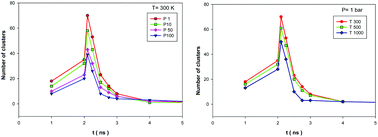当前位置:
X-MOL 学术
›
Inorg. Chem. Front.
›
论文详情
Our official English website, www.x-mol.net, welcomes your feedback! (Note: you will need to create a separate account there.)
Au–Ir nanoalloy nucleation during the gas-phase condensation: a comprehensive MD study including different effects†
Inorganic Chemistry Frontiers ( IF 7 ) Pub Date : 2018-04-21 00:00:00 , DOI: 10.1039/c8qi00177d Mohsen Abbaspour 1, 2, 3, 4, 5 , Hamed Akbarzadeh 1, 2, 3, 4, 5 , Zahra Valizadeh 1, 2, 3, 4, 5
Inorganic Chemistry Frontiers ( IF 7 ) Pub Date : 2018-04-21 00:00:00 , DOI: 10.1039/c8qi00177d Mohsen Abbaspour 1, 2, 3, 4, 5 , Hamed Akbarzadeh 1, 2, 3, 4, 5 , Zahra Valizadeh 1, 2, 3, 4, 5
Affiliation

|
We have investigated the formation of pure Ir, Ir0.75Au0.25, Ir0.5Au0.5, Ir0.25Au0.75, and pure Au nanoclusters through the inert-gas condensation method using MD simulation. The effects of mole fraction, temperature, and pressure on the different thermodynamic and structural properties of the produced nanoclusters have been investigated. The results showed that the size and number of the formed clusters increased with the increasing temperature and pressure; this was in good agreement with the experimental results obtained for metallic clusters. Our results also show that the stability of the produced nanoclusters increases as the Au mole fraction increases, whereas their stability decreases as the temperature and pressure increase. The Au atoms tend to lie on the cluster surface, whereas the Ir atoms tend to lie at the cluster cores. The percent of the surface Au atoms also increased as the Au mole fraction, temperature, and pressure increased. The radial distribution function (RDF) results indicate that the core–shell structures have not been produced in these simulations. We have also shown that the sphericity of the produced smaller clusters increases with the increasing Au mole fraction. The sphericity also increased with the increasing temperature and pressure. Our structural investigations also showed that some ordered clusters containing the fcc and hcp atoms were formed during these simulations. The percentage of the fcc atoms also increased with the increasing pressure. However, the surface of the produced clusters contained disordered atoms.
中文翻译:

气相缩合过程中的Au–Ir纳米合金成核:包括不同影响的全面MD研究†
我们研究了纯Ir,Ir 0.75 Au 0.25,Ir 0.5 Au 0.5,Ir 0.25 Au 0.75的形成,并使用MD模拟通过惰性气体冷凝法获得纯金纳米团簇。已经研究了摩尔分数,温度和压力对所产生的纳米团簇的不同热力学和结构性质的影响。结果表明,随着温度和压力的增加,形成的团簇的大小和数量增加。这与金属团簇的实验结果非常吻合。我们的结果还表明,随着Au摩尔分数的增加,产生的纳米团簇的稳定性增加,而随着温度和压力的增加,它们的稳定性降低。Au原子倾向于位于团簇表面,而Ir原子倾向于位于团簇核。表面金原子的百分比也随着金的摩尔分数,温度,和压力增加。径向分布函数(RDF)的结果表明,在这些模拟中并未生成核壳结构。我们还表明,所产生的较小簇的球形度随Au摩尔分数的增加而增加。球形度也随着温度和压力的增加而增加。我们的结构研究还表明,在这些模拟过程中形成了一些包含fcc和hcp原子的有序簇。fcc原子的百分比也随着压力的增加而增加。但是,产生的团簇的表面含有无序原子。我们还表明,所产生的较小簇的球形度随Au摩尔分数的增加而增加。球形度也随着温度和压力的增加而增加。我们的结构研究还表明,在这些模拟过程中形成了一些包含fcc和hcp原子的有序簇。fcc原子的百分比也随着压力的增加而增加。但是,产生的团簇的表面含有无序原子。我们还表明,所产生的较小簇的球形度随Au摩尔分数的增加而增加。球形度也随着温度和压力的增加而增加。我们的结构研究还表明,在这些模拟过程中形成了一些包含fcc和hcp原子的有序簇。fcc原子的百分比也随着压力的增加而增加。但是,产生的团簇的表面含有无序原子。
更新日期:2018-04-21
中文翻译:

气相缩合过程中的Au–Ir纳米合金成核:包括不同影响的全面MD研究†
我们研究了纯Ir,Ir 0.75 Au 0.25,Ir 0.5 Au 0.5,Ir 0.25 Au 0.75的形成,并使用MD模拟通过惰性气体冷凝法获得纯金纳米团簇。已经研究了摩尔分数,温度和压力对所产生的纳米团簇的不同热力学和结构性质的影响。结果表明,随着温度和压力的增加,形成的团簇的大小和数量增加。这与金属团簇的实验结果非常吻合。我们的结果还表明,随着Au摩尔分数的增加,产生的纳米团簇的稳定性增加,而随着温度和压力的增加,它们的稳定性降低。Au原子倾向于位于团簇表面,而Ir原子倾向于位于团簇核。表面金原子的百分比也随着金的摩尔分数,温度,和压力增加。径向分布函数(RDF)的结果表明,在这些模拟中并未生成核壳结构。我们还表明,所产生的较小簇的球形度随Au摩尔分数的增加而增加。球形度也随着温度和压力的增加而增加。我们的结构研究还表明,在这些模拟过程中形成了一些包含fcc和hcp原子的有序簇。fcc原子的百分比也随着压力的增加而增加。但是,产生的团簇的表面含有无序原子。我们还表明,所产生的较小簇的球形度随Au摩尔分数的增加而增加。球形度也随着温度和压力的增加而增加。我们的结构研究还表明,在这些模拟过程中形成了一些包含fcc和hcp原子的有序簇。fcc原子的百分比也随着压力的增加而增加。但是,产生的团簇的表面含有无序原子。我们还表明,所产生的较小簇的球形度随Au摩尔分数的增加而增加。球形度也随着温度和压力的增加而增加。我们的结构研究还表明,在这些模拟过程中形成了一些包含fcc和hcp原子的有序簇。fcc原子的百分比也随着压力的增加而增加。但是,产生的团簇的表面含有无序原子。



























 京公网安备 11010802027423号
京公网安备 11010802027423号